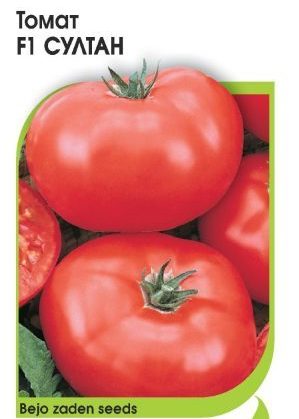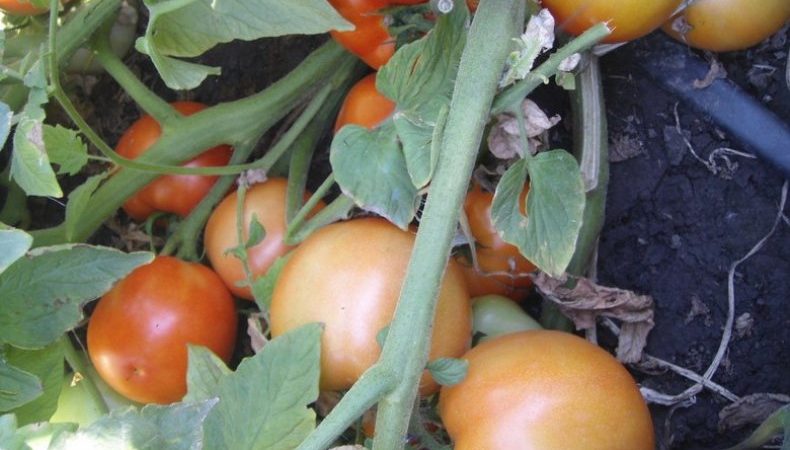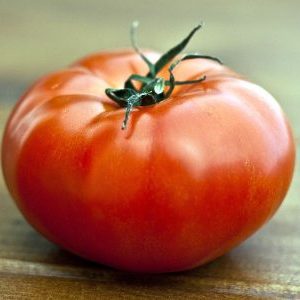A welcome guest on your site is the Sultan tomato: we grow it without hassle and enjoy the harvest
Tomatoes are an integral part of the diet of a modern person. They are included in many first and second courses, they are consumed fresh and processed. Most gardeners grow them on their plots.
The most popular are tomatoes with long-term fruiting. They provide the gardener with a harvest from mid-summer until the first frost. Choosing such tomato varieties should be done with great care. It is at the end of summer that epidemics of plant diseases occur most often. Tomato Sultan is famous for its high immunity. This hybrid is not only not afraid of late blight and other infections, but also has a bright, rich taste.
The content of the article
general description
Tomato Sultan is the development of Dutch breeders. The f1 designation indicates that this is a first generation hybrid, which means that its seeds from its fruits are not suitable for growing.
This hybrid is patented by Bejo Zaden. In our country, it is produced by such manufacturers as Prestige, Gavrish and Plasma Seeds.
In 2000, the Sultan was entered into the Russian register. It is recommended for cultivation in the central and southern regions.
Features of the Sultan

Tomato Sultan is a hybrid that is easy to care for. Its compact bushes reach a height of only 50-60 cm. It does not need pinching, which reduces labor costs when growing it.
The fruits are ordinary, red, medium-sized. Aligned as pictured. They have a rich tomato flavor with a slight sourness, which is not typical for all hybrids. The pulp is firm, tender and juicy.
An important feature of the Sultan for gardeners is the duration of fruiting. The first fruits ripen by mid-July, the latter are removed from the bush in the second half of September.
Immunity is high. The hybrid is not afraid of fungal diseases, tobacco mosaic, fusarium wilting. Rarely gets sick late blight.
Main characteristics
Tomato Sultan combines the positive characteristics of red-fruited varieties and hybrids. To collect delicious tomato berries all summer long, the gardener does not have to work too hard:
| Parameter | Indicators |
| Bush type | Determinant (independently stops its growth) .Not standard. The bushes do not exceed 60 cm in height. The stems are powerful and strong. The amount of foliage is moderate. Leaves are simple, small in size, dark green, without pubescence. The first inflorescence is formed in the axil of 5-6 leaves, the next clusters are formed every 2-3 leaves. Fruits are formed in clusters of 5-7 pieces. Up to 6 brushes grow on one plant. |
| Growing method | In the southern regions, it is cultivated in the open field. In the central and northern ones - mainly in greenhouses or under film shelters. |
| Yield | High. For the season from 1 sq. m harvest about 17 kg. |
| Fruit | Medium size. The weight of one berry varies between 100-200 g. The shape is round, flattened at the base. There is a slight ribbing at the base. Unripe berries are dark green. Ripe - bright red inside and outside without a green spot at the base. The skin is glossy, thin, but firm.The fruits have a large amount of dense but tender pulp. The taste is sweet with sourness. The dry matter content reaches 5%, and the average sugar concentration is 2.8%. One berry contains from 6 to 8 chambers. |
| Transportability | High. They do not lose their shape during transportation and are stored for up to a month. |
| Ripening terms | Medium early. The first fruits ripen 100-110 days after sowing the seeds. Fruiting continues until the first frost. |
| Disease resistance | It has immunity to most diseases common to nightshade crops. |
Note! The Sultan's taste depends on his agricultural technique. The more sun the plants receive, the sweeter the fruits will be.
Growing seedlings
In our country, medium early tomatoes are grown in seedlings. The time of sowing seeds depends on the climate of the region in which they are cultivated:
- southern - in early February;
- central - early March for the greenhouse and the end of March for open ground;
- northern - end of March for greenhouses.
The sowing time of the seeds is calculated so that the seedlings are ready for picking to a permanent place in 55-60 days. It is impossible to overexpose seedlings in pots. This will lead to a decrease in survival in new conditions.
Do I need to process seeds
Most firms pickle Dutch hybrid seeds in the factory. They are also covered with a shell containing all the essential nutrients. Such planting material is sorted out, checking for damaged and darkened seeds, and sown without pretreatment.
If the instructions do not indicate information on seed treatment, then they are soaked in special solutions at home:
- In a glass of water with a teaspoon of salt for half an hour. This procedure allows you to check the germination of the planting material. Floated seeds are considered unsuitable for planting.
- In a solution of potassium permanganate or hydrogen peroxide for 20 minutes. Such means disinfect planting material, reduce the risks of plant infection in the future.
- In "Epin", "Zircon" or "Sodium humate". Treatment of seed material with growth stimulants is needed to impregnate it with nutrients. This accelerates seed germination and increases their germination capacity.
Selection of containers and soil
For sowing a large number of seeds, boxes or trays are used. Handy tools, such as cut bottles, cake packaging, etc., will work.
If you plan to plant only a few tomato bushes, then it is advisable to use peat tablets. It is possible to germinate seeds without soil, in this case any container will do.
Dive seedlings into plastic or peat pots. A more economical option is disposable cups.
All containers are disinfected. They are poured with boiling water or a dark pink solution of potassium permanganate, Processing should last at least 30 minutes.
Soil for tomatoes is bought in a store or prepared independently. A versatile loose and nutritious mixture is suitable for tomatoes. It is made by mixing in equal proportions black soil, humus and baking powder (sand, crushed coconut substrate, sawdust).
The soil for tomatoes is also disinfected. It is calcined in the oven, poured with boiling water or a dark pink solution of potassium permanganate.
Sowing seeds in the ground and without land
The soil is poured into the box so that 3 cm of unfilled soil remains to the edge. The soil is watered with warm water. In it, grooves are made with a depth of 1 cm at a distance of 3 cm from each other.
Seeds are placed in the grooves at a distance of 2 cm. They are sprinkled with earth. The containers are covered with foil and placed in a warm place.
Some gardeners practice growing seedlings without land. In this case, the sowing technology of the planting material will differ:
- It is convenient to use a one and a half liter bottle cut lengthwise as a container for germinating seeds.
- The bottom of the container is covered with several layers of napkins or toilet paper.It is moistened with warm water.
- Seeds are spread on paper. There should be a distance of 1-2 cm between them.
- From above, the planting material is covered with several layers of paper, which are moistened with warm water from a spray bottle. The containers are covered with foil and placed in a warm place. It is important to ensure that the paper does not dry out.
- When cotyledon leaves appear on sprouted plants, they are dived into individual pots.
Tomato seedling care
It depends on the proper care of the seedlings whether the plants will take root after the pick or not. To get healthy and viable tomatoes, there are seven simple things to do:
- Watering. Water the tomatoes as the soil dries out, always with settled water at room temperature. Liquid stagnation should not be allowed, this will lead to the death of plants. It is important to ensure that no water gets on the leaves of the seedlings.
- Greenhouse. The plants need extreme humidity for the first week after seed germination. It is provided by film or glass. Then the impromptu greenhouse is dismantled.
- Shine. Young tomatoes need 16 hours of daylight hours. If there is not enough natural light, this is compensated by using fluorescent lamps.
- Temperature... For seeds to germinate quickly, they need a temperature of 25-27 ° C. A week after the appearance of the first shoots, the plants take out rooms with indicators of 17 ° C for 7 days. They are then grown at room temperature.
- Picking... Seedlings are planted in individual pots after the formation of 2-3 true leaves. A drainage layer is poured onto the bottom of containers with a volume of at least 300 ml.
- Top dressing... For the entire period of growing seedlings, it is fed 3 times. They use complex fertilizers with phosphorus in the composition. This substance promotes the development of a strong root system.
- Hardening... 14 days before planting tomatoes in open ground, they begin to be taken out onto the street or onto the balcony. For the first time, their duration in the fresh air should not exceed 30 minutes. Then the time is gradually increased to 16 hours.
Sultan's Agrotechnics
Sultan tomato is grown in the open field in the southern regions. In cities with a cold climate - in greenhouses. In the central strip, both options are possible.
In the southern regions, tomatoes are planted in a permanent place in early May, in cities with a temperate climate - at the end of May. In the northern part of Russia, seedlings are planted in protected ground at the end of May.
Before planting in a permanent place, seedlings are fed and watered. It is easier to remove plants from wet soil.
Planting seedlings to a permanent place
Tomatoes are light-loving plants. The sunniest part of the garden is chosen for them. Beds that did not grow nightshade crops last year will do.
The selected place is dug up and cleaned of plants. Humus or mullein is introduced into the soil. If the acidity of the soil is increased, dry lime is added to it. If the soil is too dense, river sand is used.
In the spring, the beds are leveled with a rake. In the process, they are cleared of weeds. The holes are dug in rows in a checkerboard pattern. For 1 sq. m planted up to six bushes of tomato Sultan.
Ash or long-acting fertilizers are poured into the bottom of the holes. After planting the tomatoes, the plants are watered. For each of them take 1 liter of water. The next watering will be possible only after 10 days.
Plant care

Despite the short stature, the plants need tie up... Otherwise, they will break under the weight of the crop. Tomatoes are attached to wooden supports or trellises. The thread for the garter is synthetic, since the natural material will rot.
Pinch such bushes are not needed. They form a small number of shoots, which provide the plant with high yields.
After the formation of the first flower cluster, the leaves that are below it are removed. No more than 3 sheets are torn off per week.
To water tomatoes are needed as the soil dries up with warm, settled water.It is important to ensure that the liquid does not get onto the ground part of the tomatoes.
After each watering and precipitation, the soil is loosened. In the process of this event, weeds are removed.
Tomatoes are fed 3-4 times during the entire growing season. Organic and mineral compositions alternate. Before fertilizing, you need to water the plants abundantly so as not to burn their roots with fertilizers.
Tomatoes are sprayed with foliar dressing twice a season. Boron-containing products are used.
Growing problems
When growing tomatoes, gardeners sometimes face a number of problems. The list provides reasons for some of them:
- A large amount of greenery is formed on the plants, and there are few ovaries. This suggests that tomatoes fatten... The reason is too fertile soil. Reduce the amount of feeding.
- Ugly fruit. The most common reasons are violation of watering conditions and temperature conditions, pests.
- Swirling leaves. Sign of plant infection. Possible reasons are excessive pinching and high humidity.
Diseases and pests
Tomato Sultan is resistant to most tomato diseases. Nevertheless, he needs disease prevention:
- Disinfection. Disinfecting compounds are used to treat not only seeds, containers and soil, but also garden tools.
- Compliance with the rules of watering and pinching. These procedures are performed when the sun is inactive. It is important to monitor the moisture level and prevent water from getting on the ground part of the plants.
- Preventive treatments. The bushes are sprayed with a solution of potassium permanganate or copper sulfate.
- Protection against harmful insects... Plants are sprayed with soapy water or wormwood decoction.
- Preventive examinations. Held weekly. The damaged bushes are removed.

The nuances of cultivation in open and protected ground
When growing tomatoes in a greenhouse, you need to ventilate the premises every week to maintain optimal humidity levels and prevent diseases.
In the greenhouse, tomatoes are watered once a week. Outdoors - 2 or 3.
After picking tomatoes in open ground, they are covered with foil for the first two weeks at night. This measure is needed to protect the bushes from night frosts.
Harvesting and application of the crop
The Sultan's harvest is harvested in the second half of July. The fruits are harvested both on the hands and by the piece. They also ripen at home, in this case there will be less sweetness in the berries.
Use the harvest of the Sultan for fresh consumption and preservation whole. Delicious juices and sauces are made from these tomatoes.
Advantages and disadvantages of a hybrid
Sultan's advantages:
- immunity to disease;
- high productivity;
- rich taste;
- universality of application;
- seeds are often sold already processed;
- no need for pinning;
- the possibility of planting thickening.
The disadvantages include the hybridity of the Sultan. The seeds from its fruit cannot be used for planting.
Farmers reviews
Reviews about the Sultan are contradictory. Some gardeners believe that nowadays there are varieties with better quality fruits with similar characteristics.

Anna, Nikopol: "I have been growing the Sultan for the third year. I plant it directly in open ground. On a garden bed of 2 sq. m fits 12 bushes. It turns out about 5 buckets of fruit with a pleasant sweet taste. Suitable for both preservation and fresh consumption. Minimal care is required. "
Igor, Zelenograd: “Last year, Sultan planted tomato. In our region, its cultivation is possible only in a greenhouse. As a greenhouse hybrid, Sultan did not like it. There are mid-early varieties with more original taste. For the sake of fairness, I note that it is really very simple to care for him. This year I will plant a couple of bushes in open ground and see what happens. "
Conclusion
Sultan tomatoes are a good-tasting hybrid with high yields. It won't surprise experienced gardeners, but it will delight beginners.Due to its high immunity to tomato diseases, short stature and the absence of the need for pinching, its cultivation requires minimal labor.